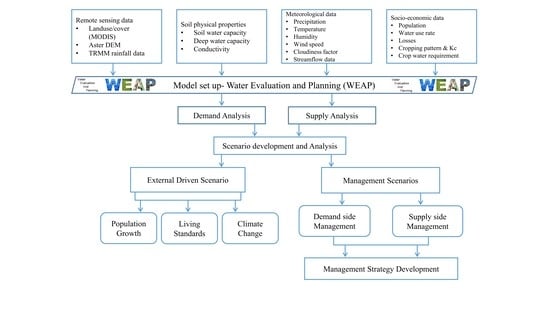Analysis of Current and Future Water Demands in the Upper Indus Basin under IPCC Climate and Socio-Economic Scenarios Using a Hydro-Economic WEAP Model
Abstract
:1. Introduction
2. Materials and Methods
2.1. Study Area
2.2. Data Collection
2.3. Methodology
2.4. Hydro-Economic WEAP Model Description
2.5. Model Setup
- The main Indus River and six small tributaries (Gilgit, Hunza. Shigar, Shyok, Shingo, and Astore)
- Eight catchment nodes. Nine domestic demands (Gilgit, Hunza, Shigar, Shyok, Shingo, Astore, Diamir, Kohistan, and the below besham streamflow site), seven agriculture demand sites, and one livestock demand site.
- Eight runoff/infiltration lines. Eighteen transmission links.
- Six streamflow gauge stations (Doyian (Astore river), Dainyor Br. (Hunza river), Shigar (Shigar river), Gilgit (Gilgit river), Yogo (Shyok river), Partab Br. (Indus River), and Besham Qila (Indus river).
Scenario Development
3. Results
3.1. Model Calibration and Validation
3.2. Scenario 1: Reference/Business as Usual
3.3. External-Driven Factor Scenarios Result
3.4. Climate Change Scenarios
3.5. Management Scenario
4. Discussion
Author Contributions
Funding
Acknowledgments
Conflicts of Interest
References
- UNEP. Status Report on the Application of Integrated Approaches to Water Resources Management; United Nations Environment Programme: Nairobi, Kenya, 2012. [Google Scholar]
- Gardner-Outlaw, T.; Engelman, R. Sustaining Water Easing Scarcity: A Second Update; Population Action International, Population and Environment Program: Washington, DC, USA, 1997. [Google Scholar]
- Liu, J.; Wang, Y.; Yu, Z.; Cao, X.; Tian, L.; Sun, S.; Wu, P. A comprehensive analysis of blue water scarcity from the production, consumption, and water transfer perspectives. Ecol. Indic. 2017, 72, 870–880. [Google Scholar] [CrossRef]
- Flato, G.; Marotzke, J.; Abiodun, B.; Braconnot, P.; Chou, S.C.; Collins, W.J.; Cox, P.; Driouech, F.; Emori, S.; Eyring, V. Evaluation of climate models. In Climate change 2013: The physical science basis. Contribution of working group I to the fifth assessment report of the intergovernmental panel on climate change. Clim. Chang. 2013, 5, 741–866. [Google Scholar] [CrossRef]
- Bao, C.; He, D. The causal relationship between urbanization, economic growth and water use change in provincial China. Sustainability 2015, 7, 16076–16085. [Google Scholar] [CrossRef]
- Saraswat, C.; Kumar, P.; Mishra, B.K. Assessment of stormwater runoff management practices and governance under climate change and urbanization: An analysis of Bangkok, Hanoi and Tokyo. Environ. Sci. Policy 2016, 64, 101–117. [Google Scholar] [CrossRef]
- Al Radif, A. Integrated water resources management (IWRM): An approach to face the challenges of the next century and to avert future crises. Desalination 1999, 124, 145–153. [Google Scholar] [CrossRef]
- Hong, X.; Guo, S.; Wang, L.; Yang, G.; Liu, D.; Guo, H.; Wang, J. Evaluating water supply risk in the middle and lower reaches of Hanjiang river basin based on an integrated optimal water resources allocation model. Water 2016, 8, 364. [Google Scholar] [CrossRef]
- Oreskes, N. The scientific consensus on climate change. Science 2004, 306, 1686. [Google Scholar] [CrossRef] [PubMed]
- Solomon, S. Climate Change 2007—The Physical Science Basis: Working Group I Contribution to the Fourth Assessment Report of the IPCC; Cambridge University Press: Cambridge, UK, 2007; Volume 4. [Google Scholar]
- Hoekstra, A.Y.; Mekonnen, M.M.; Chapagain, A.K.; Mathews, R.E.; Richter, B.D. Global monthly water scarcity: Blue water footprints versus blue water availability. PLoS ONE 2012, 7, e32688. [Google Scholar] [CrossRef] [PubMed]
- Babel, M.; Gupta, A.D.; Nayak, D. A model for optimal allocation of water to competing demands. Water Resour. Manag. 2005, 19, 693–712. [Google Scholar] [CrossRef]
- Young, G.J.; Hewitt, K. Hydrology research in the upper Indus basin, Karakoram Himalaya, Pakistan. Hydrol. Mt. Areas IAHS Publ. 1990, 190, 139–152. [Google Scholar]
- Karim, A.; Veizer, J. Water balance of the Indus river basin and moisture source in the karakoram and western himalayas: Implications from hydrogen and oxygen isotopes in river water. J. Geophys. Res. Atmos. 2002, 107. [Google Scholar] [CrossRef]
- Jain, S.K.; Agarwal, P.K.; Singh, V.P. Indus Basin; Springer: Dordrecht, The Netherlands, 2007. [Google Scholar]
- Hussain, I.; Hussain, Z.; Sial, M.H.; Akram, W.; Farhan, M. Water balance, supply and demand and irrigation efficiency of Indus basin. Pak. Econ. Soc. Rev. 2011, 49, 13–38. [Google Scholar]
- Watkins, K. Human Development Report 2006-beyond Scarcity: Power, Poverty and the Global Water Crisis. Available online: https://ssrn.com/abstract=2294691 (accessed on 26 March 2018).
- Perera, B.; James, B.; Kularathna, M. Computer software tool realm for sustainable water allocation and management. J. Environ. Manag. 2005, 77, 291–300. [Google Scholar] [CrossRef] [PubMed]
- Cai, X.; Kam, S.P.; Yen, B.T.; Sood, A.; Chu Thai, H. Cawat—A Catchment Water Allocation Tool for Integrated Irrigation and Aquaculture Development in Small Watersheds. 2014. Available online: https://academicworks.cuny.edu/cc_conf_hic/381/ (accessed on 26 March 2018).
- Harma, K.J.; Johnson, M.S.; Cohen, S.J. Future water supply and demand in the Okanagan basin, British columbia: A scenario-based analysis of multiple, interacting stressors. Water Resour. Manag. 2012, 26, 667–689. [Google Scholar] [CrossRef]
- Raskin, P.; Hansen, E.; Zhu, Z.; Stavisky, D. Simulation of water supply and demand in the aral sea region. Water Int. 1992, 17, 55–67. [Google Scholar] [CrossRef]
- Yates, D.; Sieber, J.; Purkey, D.; Huber-Lee, A. Weap21—A demand-, priority-, and preference-driven water planning model: Part 1: Model characteristics. Water Int. 2005, 30, 487–500. [Google Scholar] [CrossRef]
- Tahir, A.A.; Chevallier, P.; Arnaud, Y.; Neppel, L.; Ahmad, B. Modeling snowmelt-runoff under climate scenarios in the hunza river basin, karakoram range, northern Pakistan. J. Hydrol. 2011, 409, 104–117. [Google Scholar] [CrossRef]
- Awan, U.K.; Liaqat, U.W.; Choi, M.; Ismaeel, A. A swat modeling approach to assess the impact of climate change on consumptive water use in lower chenab canal area of Indus basin. Hydrol. Res. 2016, 47, 1025–1037. [Google Scholar] [CrossRef]
- O’Mara, G.T.; Duloy, J.H. Modeling efficient water allocation in a conjunctive use regime: The Indus basin of Pakistan. Water Resour. Res. 1984, 20, 1489–1498. [Google Scholar] [CrossRef]
- Sharma, B.R.; Cai, X.; Condappa, D.D. Impact of Climate Change on Water Resources and Agricultural Production in the Indus Basin, South Asia; International Water Resources Association (IWRA): Urbana, IL, USA, 2011. [Google Scholar]
- Kiniouar, H.; Hani, A.; Kapelan, Z. Water demand assessment of the upper semi-arid sub-catchment of a mediterranean basin. Energy Procedia 2017, 119, 870–882. [Google Scholar] [CrossRef]
- Ahmadaali, J.; Barani, G.-A.; Qaderi, K.; Hessari, B. Analysis of the effects of water management strategies and climate change on the environmental and agricultural sustainability of Urmia lake basin, Iran. Water 2018, 10, 160. [Google Scholar] [CrossRef]
- Yates, D.; Purkey, D.; Sieber, J.; Huber-Lee, A.; Galbraith, H. Weap21—A demand-, priority-, and preference-driven water planning model: Part 2: Aiding freshwater ecosystem service evaluation. Water Int. 2005, 30, 501–512. [Google Scholar] [CrossRef]
- Toure, A.; Diekkrüger, B.; Mariko, A.; Cissé, A.S. Assessment of groundwater resources in the context of climate change and population growth: Case of the klela basin in southern mali. Climate 2017, 5, 45. [Google Scholar] [CrossRef]
- Esteve, P.; Varela-Ortega, C.; Blanco-Gutiérrez, I.; Downing, T.E. A hydro-economic model for the assessment of climate change impacts and adaptation in irrigated agriculture. Ecol. Econ. 2015, 120, 49–58. [Google Scholar] [CrossRef]
- Sieber, J.; Purkey, D. Weap: Water Evaluation and Planning System; User Guide; Stockholm Environment Institute, US Center: Somerville, MA, USA, 2011; Available online: http://weap21.org/downloads/WEAP_User_Guide.pdf (accessed on 26 March 2018).
- Spalding-Fecher, R.; Joyce, B.; Winkler, H. Climate change and hydropower in the Southern African power pool and Zambezi river basin: System-wide impacts and policy implications. Energy Policy 2017, 103, 84–97. [Google Scholar] [CrossRef]
- Clarke, L.; Edmonds, J.; Jacoby, H.; Pitcher, H.; Reilly, J.; Richels, R. Scenarios of Greenhouse Gas Emissions and Atmospheric Concentrations; US Department of Energy Publications; US Department of Energy: Washington, DC, USA, 2007; Volume 6.
- Riahi, K.; Grübler, A.; Nakicenovic, N. Scenarios of long-term socio-economic and environmental development under climate stabilization. Technol. Forecast. Soc. Chang. 2007, 74, 887–935. [Google Scholar] [CrossRef]
- Blanco-Gutiérrez, I.; Varela-Ortega, C.; Flichman, G. Cost-effectiveness of groundwater conservation measures: A multi-level analysis with policy implications. Agric. Water Manag. 2011, 98, 639–652. [Google Scholar] [CrossRef] [Green Version]
- McCuen, R.H.; Knight, Z.; Cutter, A.G. Evaluation of the nash–sutcliffe efficiency index. J. Hydrol. Eng. 2006, 11, 597–602. [Google Scholar] [CrossRef]
- Ritter, A.; Muñoz-Carpena, R. Performance evaluation of hydrological models: Statistical significance for reducing subjectivity in goodness-of-fit assessments. J. Hydrol. 2013, 480, 33–45. [Google Scholar] [CrossRef]
- Pakistan Meteorological Department. Pakistan Meteorological Department, govt. of Pakistan. Available online: http://www.pmd.gov.pk/ (accessed on 6 April 2018).
- Saraswat, C.; Mishra, B.K.; Kumar, P. Integrated urban water management scenario modeling for sustainable water governance in Kathmandu valley, Nepal. Sustain. Sci. 2017, 12, 1037–1053. [Google Scholar] [CrossRef]
- Adgolign, T.B.; Rao, G.S.; Abbulu, Y. Weap modeling of surface water resources allocation in Didessa sub-basin, west Ethiopia. Sustain. Water Resour. Manag. 2016, 2, 55–70. [Google Scholar] [CrossRef]
- Khalil, A.; Rittima, A.; Phankamolsil, Y. The projected changes in water status of the Mae Klong basin, Thailand, using Weap model. Paddy Water Environ. 2018, 1–17. [Google Scholar] [CrossRef]
- Archer, D.R.; Fowler, H.J. Spatial and temporal variations in precipitation in the upper Indus basin, global teleconnections and hydrological implications. Hydrol. Earth Syst. Sci. Discuss. 2004, 8, 47–61. [Google Scholar] [CrossRef]
- Archer, D. Contrasting hydrological regimes in the Upper Indus basin. J. Hydrol. 2003, 274, 198–210. [Google Scholar] [CrossRef]
- Archer, D.R.; Forsythe, N.; Fowler, H.J.; Shah, S.M. Sustainability of water resources management in the Indus basin under changing climatic and socio economic conditions. Hydrol. Earth Syst. Sci. 2010, 14, 1669–1680. [Google Scholar] [CrossRef] [Green Version]
- Briscoe, J.; Qamar, U.; Contijoch, M.; Amir, P.; Blackmore, D. Pakistan’s Water Economy: Running Dry; Oxford University Press: Karachi, Pakistan, 2005; p. 140. [Google Scholar]
- Bocchiola, D.; Diolaiuti, G.; Soncini, A.; Mihalcea, C.; D’agata, C.; Mayer, C.; Lambrecht, A.; Rosso, R.; Smiraglia, C. Prediction of future hydrological regimes in poorly gauged high altitude basins: The case study of the upper Indus, Pakistan. Hydrol. Earth Syst. Sci. 2011, 15, 2059–2075. [Google Scholar] [CrossRef] [Green Version]
- Arranz, R.; McCartney, M.P. Application of the Water Evaluation and Planning (WEAP) Model to Assess Future Water Demands and Resources in the Olifants Catchment, South Africa; IWMI: Colombo, Sri Lanka, 2007; Volume 116.

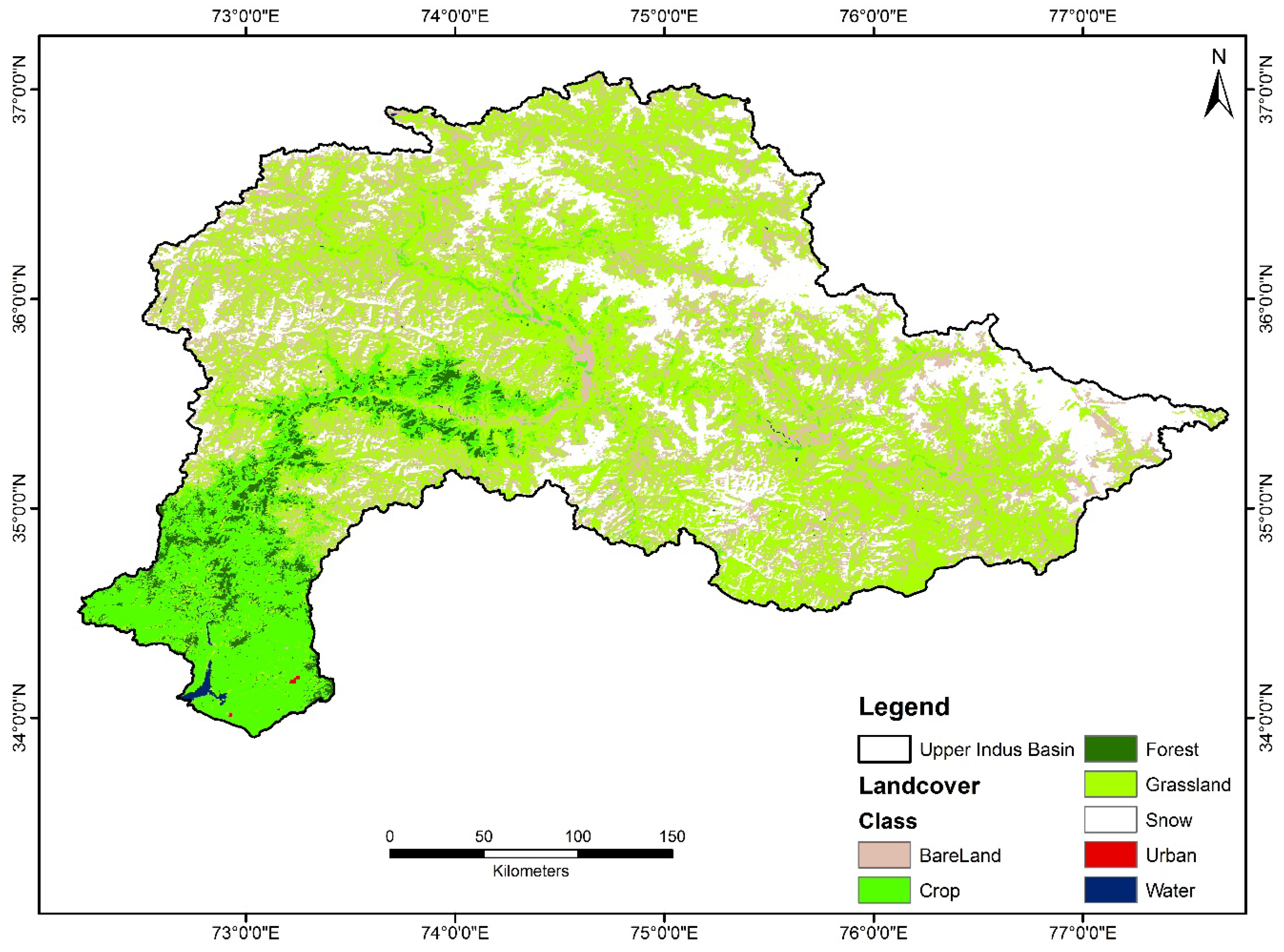
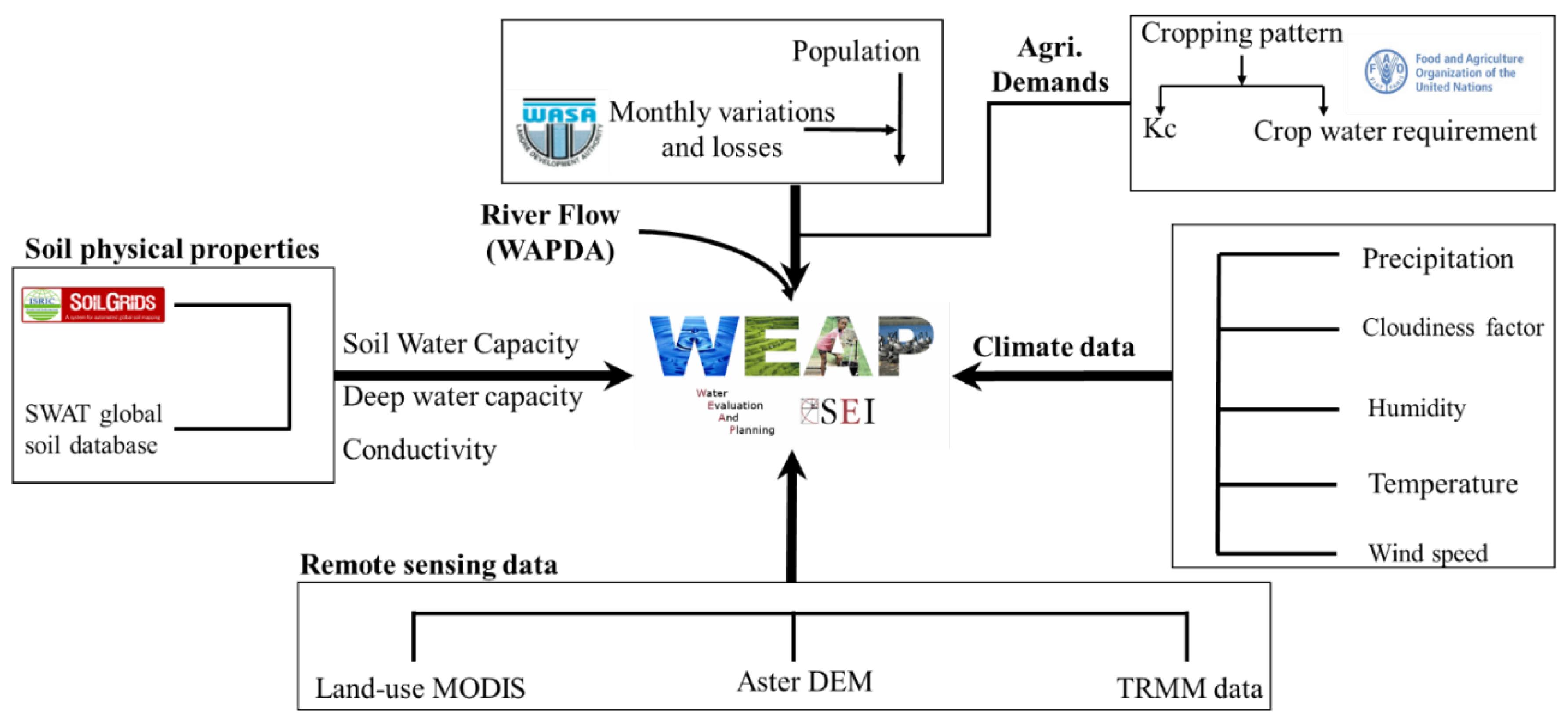


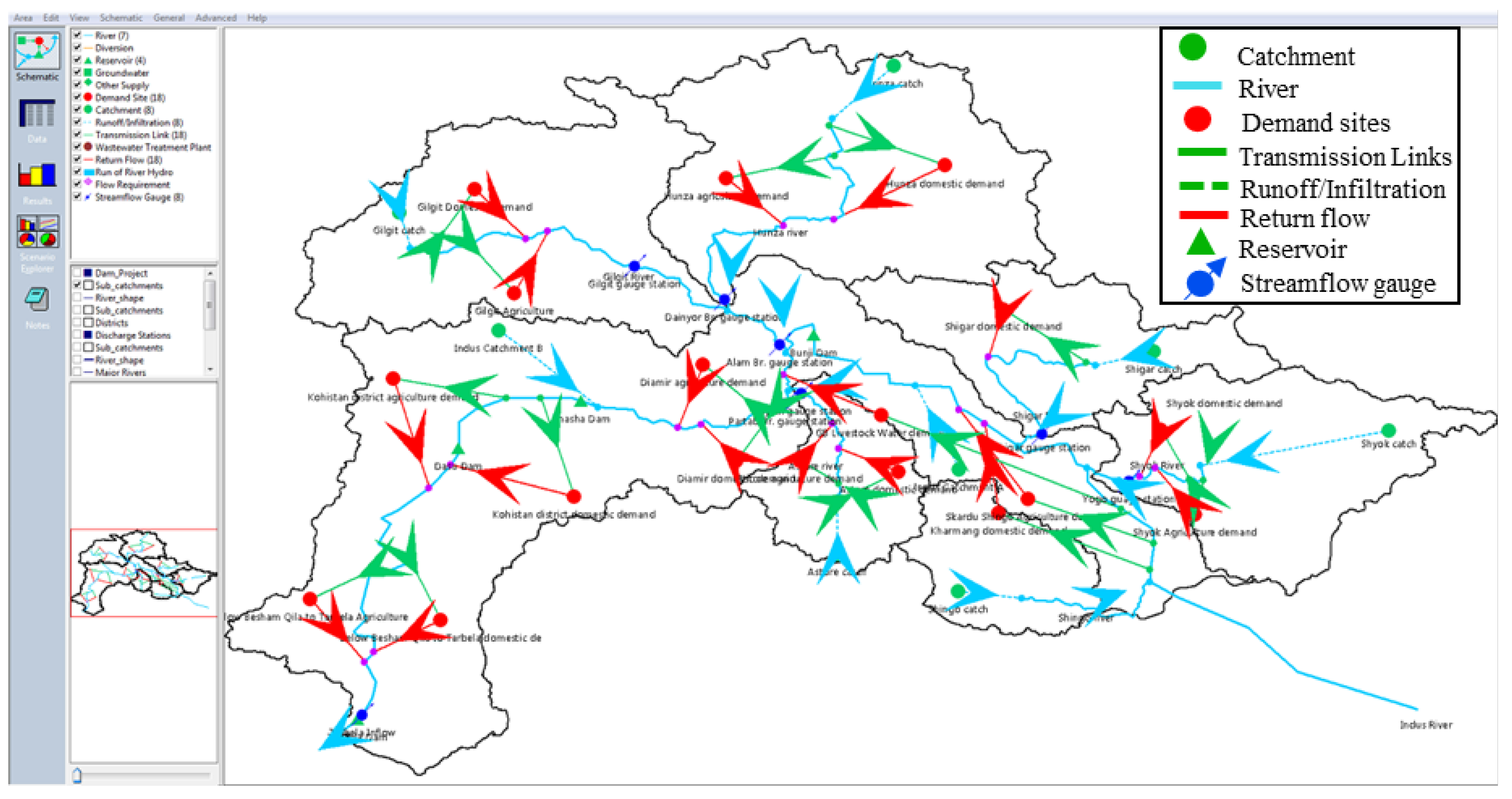



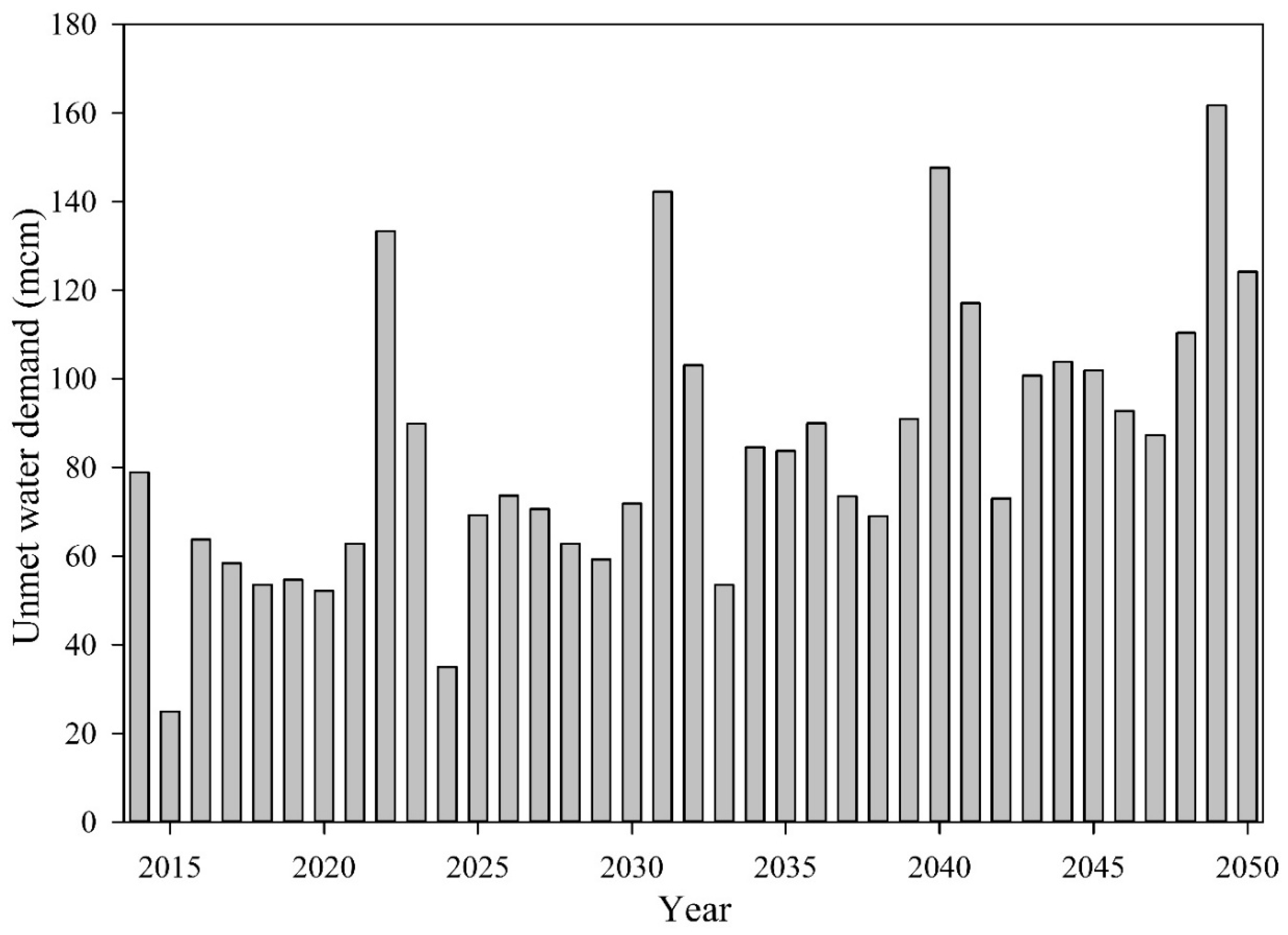





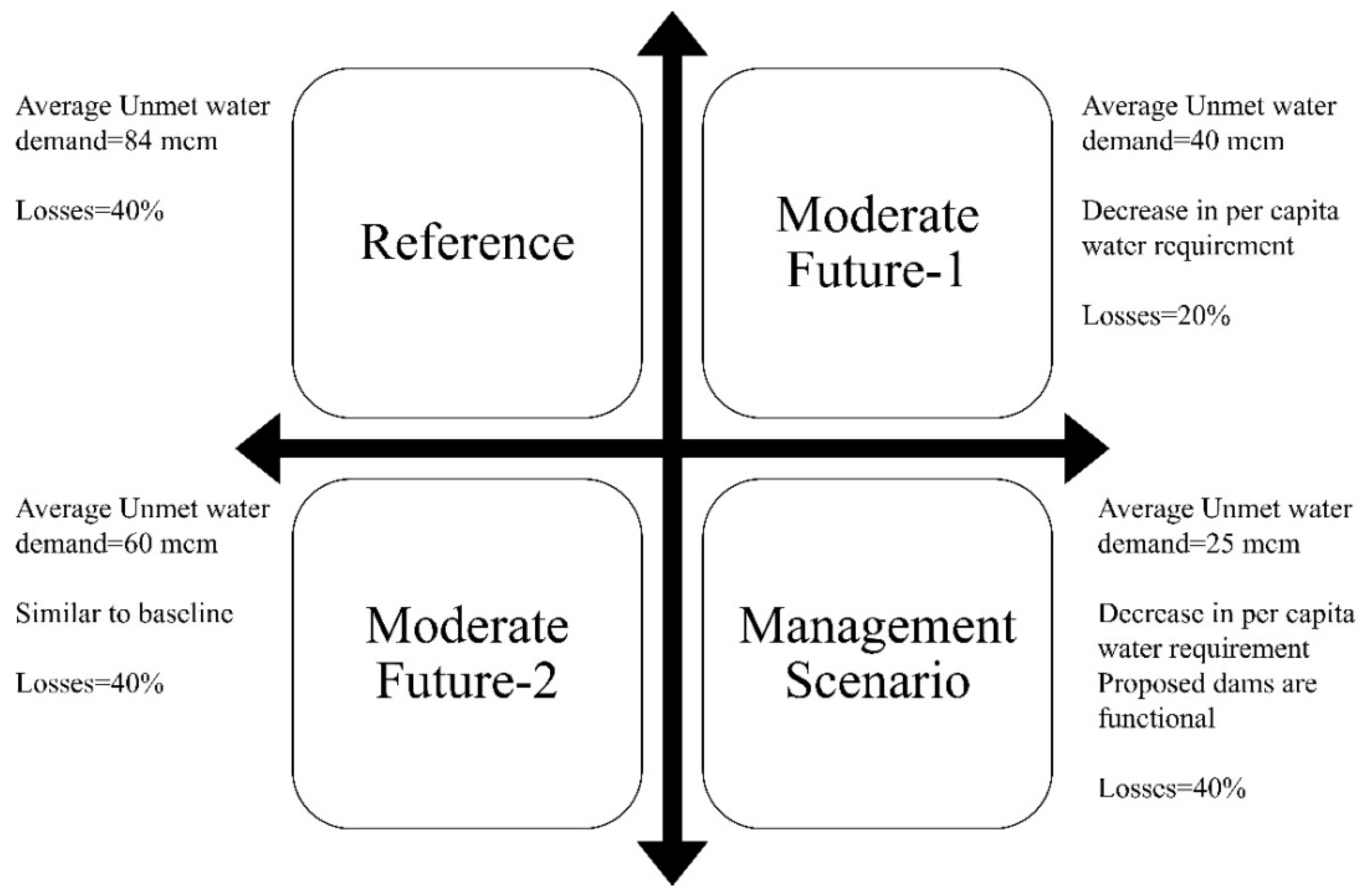
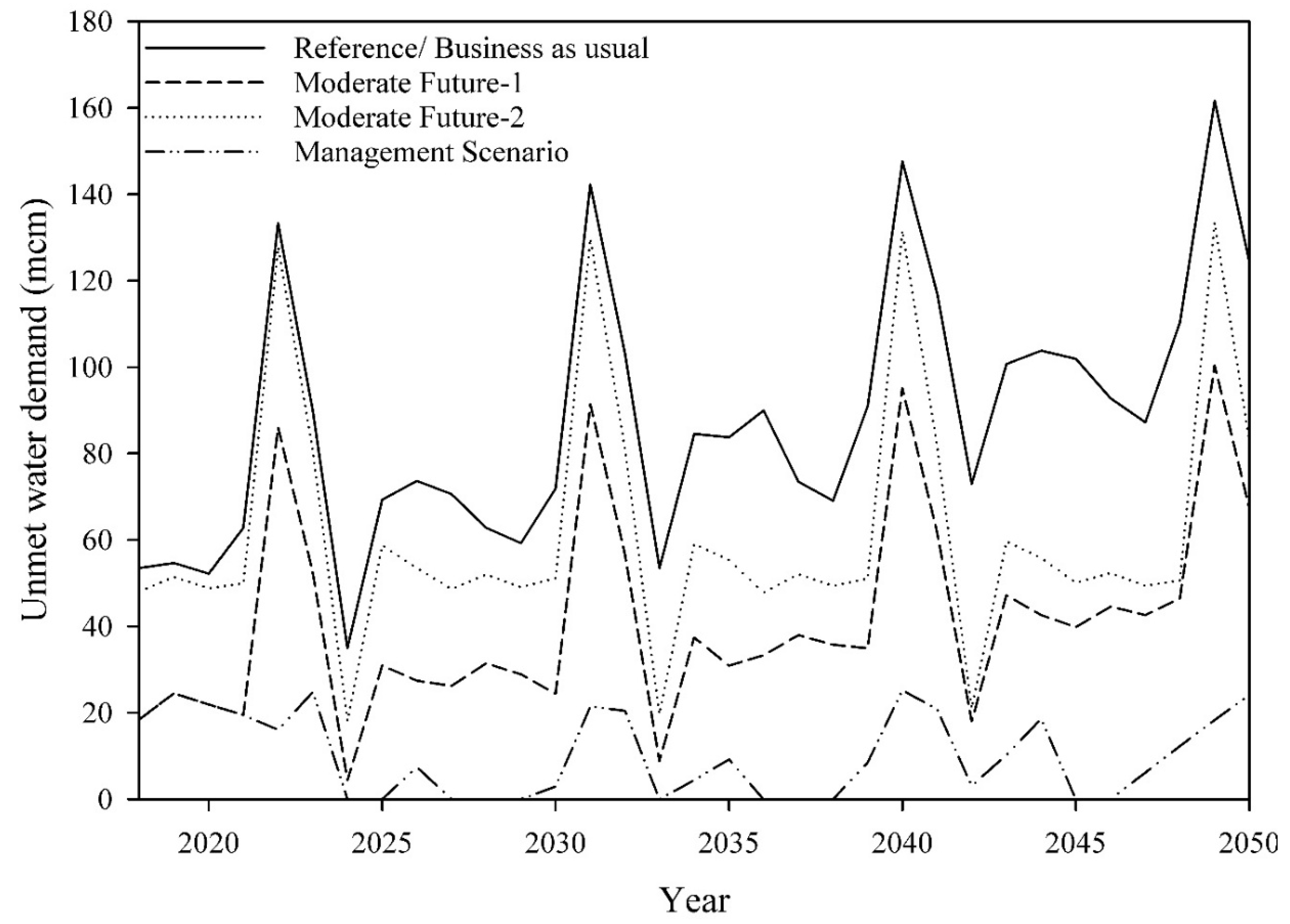
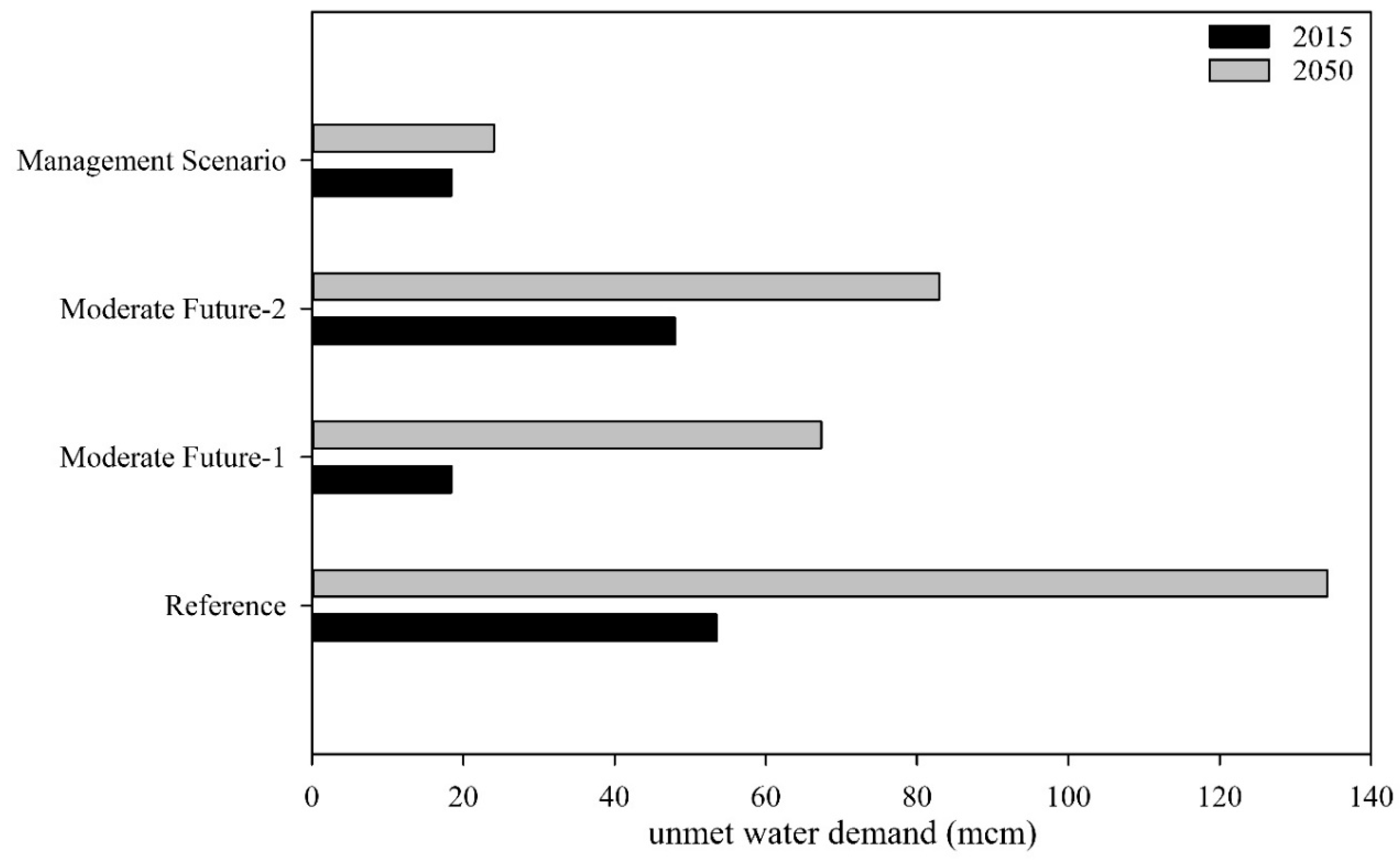
| Data | Description | Sources |
|---|---|---|
| Remote sensing data | Digital Elevation Model for catchment delineation, land cover from MODIS, and TRMM data for precipitation | USGS (https://earthexplorer.usgs.gov/) |
| Climate data (2006–2014) | Precipitation, Temperature Humidity, Cloudiness factor, Wind speed | Pakistan Meteorological Department |
| Hydrological data (2006–2014) | Gauge station data, Reservoirs | Water And Power Development Authority, Indus River System Authority and PMD |
| Demand data | Land use data Urban sector Population Water use rates Water consumption Agricultural sector | Socio-Economic Surveys (Census 1998) and growth rate, Irrigation Department (Pakistan) and agriculture census data |
| Parameters | Model Range | Optimal Range (for Different Land Covers) |
|---|---|---|
| Soil water capacity | 0-higher (mm) | 0–1200 (mm) |
| Root zone conductivity | Default = 20 mm | 10–50 (mm) |
| Deep conductivity | 0.1-higher (mm/month) Default = 20 mm | Default = 20 mm |
| Runoff resistance factor | 0–1000 (default = 2) | 0–100 |
| Preferred flow direction | 0–1 (default = 0.15) | 0.5–1 |
© 2018 by the authors. Licensee MDPI, Basel, Switzerland. This article is an open access article distributed under the terms and conditions of the Creative Commons Attribution (CC BY) license (http://creativecommons.org/licenses/by/4.0/).
Share and Cite
Amin, A.; Iqbal, J.; Asghar, A.; Ribbe, L. Analysis of Current and Future Water Demands in the Upper Indus Basin under IPCC Climate and Socio-Economic Scenarios Using a Hydro-Economic WEAP Model. Water 2018, 10, 537. https://doi.org/10.3390/w10050537
Amin A, Iqbal J, Asghar A, Ribbe L. Analysis of Current and Future Water Demands in the Upper Indus Basin under IPCC Climate and Socio-Economic Scenarios Using a Hydro-Economic WEAP Model. Water. 2018; 10(5):537. https://doi.org/10.3390/w10050537
Chicago/Turabian StyleAmin, Ali, Javed Iqbal, Areesha Asghar, and Lars Ribbe. 2018. "Analysis of Current and Future Water Demands in the Upper Indus Basin under IPCC Climate and Socio-Economic Scenarios Using a Hydro-Economic WEAP Model" Water 10, no. 5: 537. https://doi.org/10.3390/w10050537
APA StyleAmin, A., Iqbal, J., Asghar, A., & Ribbe, L. (2018). Analysis of Current and Future Water Demands in the Upper Indus Basin under IPCC Climate and Socio-Economic Scenarios Using a Hydro-Economic WEAP Model. Water, 10(5), 537. https://doi.org/10.3390/w10050537



